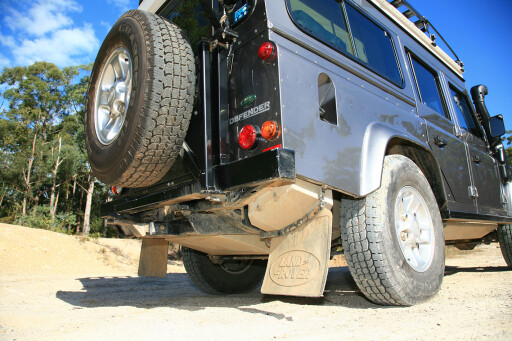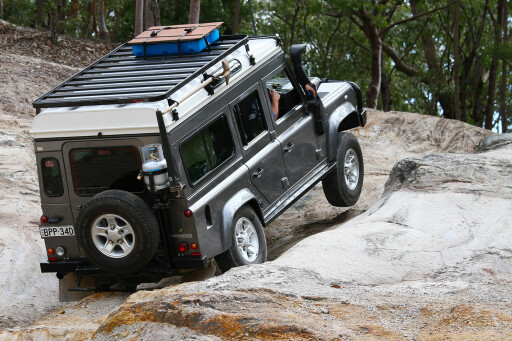
HOW'S this for gutsy: buy a brand-spankin’ new 4X4 (about the $50 to 60k mark) and cut the roof clean off.
This article was first published in 4x4 Australia's June 2012 issue.
It takes a reasonable amount of courage to stand back and watch another fella remove a perfectly good lid from a perfectly good 4X4. Fred Mayer, the brave and determined owner of this Defender 110, has done just that. Not that you’d immediately pick it from the photos.
That is, until the new roof is popped open to reveal the camper set-up – it’s an absolute ripper for a touring couple and detracts very little from the original lines of the Land Rover. You see, Fred was intent on creating his version of the perfect touring vehicle and wanted to start with a clean slate.
 He did, however, have a fair idea about who was going to do the big chop to his new home-on-wheels – he even had the rest of the wagon’s future mapped out well before handing over his cheque to the salesman.
He did, however, have a fair idea about who was going to do the big chop to his new home-on-wheels – he even had the rest of the wagon’s future mapped out well before handing over his cheque to the salesman.
Keen Landie spotters will no doubt pick the slight difference in the roof line when in driving mode, with only a few inches of extra metalwork showing outside the factory Land Rover technical drawings. Even that extra metalwork has been colour-coded to match the body, so as not to stand out; not that this roof was white from factory, mind you.
Hands up how many Defender enthusiasts spotted that? The roof of the latest Defenders are colour-coded to the body – that’s product development for you. Fred drove his Defender straight over to Daniel at Mulgo Expedition Vehicles & Equipment (Mortdale, NSW) for the pop-top camper replacement.
 Off came the standard roof, on went the pop-up camper lid, complete with gas struts, lightweight canvas walls and extra metal wall height built in around the top of the standard Defender.
Off came the standard roof, on went the pop-up camper lid, complete with gas struts, lightweight canvas walls and extra metal wall height built in around the top of the standard Defender.
Of course there is much more to it than that, but Daniel has created a brilliantly easy pop-top roof system that is ideal for camping and doesn’t detract from the day-to-day useability of the wagon, even when it’s being driven around town.
While Mulgo had Fred’s wagon, it also added its ExBox conversion, where all the electronics fitted under the driver’s seat as standard are re-positioned under the centre console (or cubby, as Land Rover calls it).
A pretty clever conversion for sure, as it allows the now released under-drivers- seat space to be used for extra storage of tools or recovery gear or even a safe hidey-hole for valuables.
 All the electronics are now in a sealed box and the centre console/cubby is now about 15cm higher – perfect for an armrest. Mulgo also installed its clever glove box conversion kit, which inserts a glove box with twin (upper and lower) opening doors, where there was previously just a blank, unused space in the dash – clever.
All the electronics are now in a sealed box and the centre console/cubby is now about 15cm higher – perfect for an armrest. Mulgo also installed its clever glove box conversion kit, which inserts a glove box with twin (upper and lower) opening doors, where there was previously just a blank, unused space in the dash – clever.
Non-Defender experts would be hard-pressed at realising there was something non-standard in the dash with this kit; it looks OE and serves its purpose well. Also fitted to the dash is a Hema Navigator and a good old-fashioned compass for remote-area trips.
As good as they are, GPS-cum-navigator units are not infallible, so Fred’s use of a compass makes sense. To keep in contact with fellow travellers, Fred uses a GME UHF radio, while longer distance comms are directed out via the remote-head Codan HF radio and auto-tuning whip antenna, which is rear mounted near the spare-wheel carrier.

Fred also opted for one of Drifta’s slide-out camp kitchens that transforms into an acre of tabletop food-preparation area, with a few drawers built in underneath.
These kitchens can be used partially in the rear of the wagon or they can be removed and used standing on their own adjustable legs under the Defender’s rear awning or down by the river’s edge – or wherever you reckon is the best vantage point to eat and watch the sunset.
Fred has also plumbed a manual water pump inside, plus a 12-volt electric water tap outside, both of which are drawn from a 65-litre sill-mounted water tank. An aluminium Front Runner WindCheetah full-length roof rack, with extra front bracing (which doubles as a tree deflector) sits on top of the lift-up camper roof.
 Fred carries a tank of water plus extra camping gear for his longer bush trips, plus this rack provides a great vantage point from which to take a few photos, or simply take in the sights. If you’re wondering how strong the Mulgo camper pop-up roof is, Daniel was issued a report from an engineer stating the design and manufacture of his handiwork is superior to the factory-standard turret.
Fred carries a tank of water plus extra camping gear for his longer bush trips, plus this rack provides a great vantage point from which to take a few photos, or simply take in the sights. If you’re wondering how strong the Mulgo camper pop-up roof is, Daniel was issued a report from an engineer stating the design and manufacture of his handiwork is superior to the factory-standard turret.
Not that you should overload the roof past the specified limit, but it’s reassuring to know the modifications haven’t compromised strength or integrity. The rear passenger door is the access point to the Bushman fridge, under which recovery gear, a few spares, camping gear and tools reside.
Again, this is a very simple and basic arrangement, but allows easy access to everything and has nothing to go wrong – perfect for bush travel.
Fred wasn’t one to leave all the mechanicals stock; rather he’s plugged in a Steinbauer performance module, together with a 100 percent larger intercooler, a washable cotton high-performance air filter and Water Watch fuel-filtration system and Safari snorkel – that should get the 2.4-litre turbo-diesel hiking and keep it clean for the long haul.
 Fred bought a set of 40mm raised springs and Koni shock absorbers from Les Richmond Automotive (a dedicated Land Rover joint) and fitted the lot himself. The additional load-carrying capacity and increase in height from the coils suits all that extra weight in water, fuel and camper kit perfectly, at least from what we could see while Fred negotiated a few steep obstacles during our shoot.
Fred bought a set of 40mm raised springs and Koni shock absorbers from Les Richmond Automotive (a dedicated Land Rover joint) and fitted the lot himself. The additional load-carrying capacity and increase in height from the coils suits all that extra weight in water, fuel and camper kit perfectly, at least from what we could see while Fred negotiated a few steep obstacles during our shoot.
Fred was more than happy to demonstrate how capable his wagon is, given the factory traction control system, longer travel suspension and his level-headed driving. We watched those coil springs flexing all over the shop to help the Defender through some pretty gnarly climbs and ruts.
That Fred could drive pretty much anywhere on our little island, pull up, have camp set up in a blink and kick back with a meal in no time is a credit to both his and his suppliers’ handiwork and products.
Should things not go quite to plan, Fred has had Mannell Motors (Thornleigh, NSW) fit an ARB steel bullbar with a Warn 9.5XP electric winch, plus he carries a plethora of recovery gear under the fridge on the passenger’s side.
 There are also front and rear QT diff protectors that mount via OE threaded holes; these steel units help the diff centres slide over rocks instead of bashing straight into them, potentially cracking the housing. To help protect the soft aluminium sills, Fred knocked up his own sliders using 75mm x 50mm box-section steel.
There are also front and rear QT diff protectors that mount via OE threaded holes; these steel units help the diff centres slide over rocks instead of bashing straight into them, potentially cracking the housing. To help protect the soft aluminium sills, Fred knocked up his own sliders using 75mm x 50mm box-section steel.
While he was at the welder, he also fabricated his own rear bar and swing-out spare wheel carrier, as well as an 8.5-litre oil and air storage canister. Geez, this fella is clever; not only are all the mods he’s done hard to pick, they all work like a charm – just goes to show he’s probably been there and done it before.
And he sure has; Fred used to be a professional four-wheel driver in Africa where he ran photography safaris into the wilds of Kenya, and he is currently one of the professional driver trainers with the Land Rovers Owners Club, so he knows his stuff and loves nothing more than getting out with his new camper conversion.
In fact, Fred was due to set off on a trip up to far-north Queensland and the Northern Territory just weeks after our photo shoot to take part in a recreation of the 1986 Camel Trophy event.
The Camel Trophy recreation let Fred test his camper where it was designed to be used. We reckon he would have had camp set up faster than most of the participants, and with many more mod cons for comfy bush camping than they would have had back in 1986.

COMMENTS